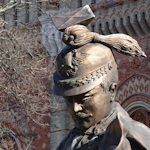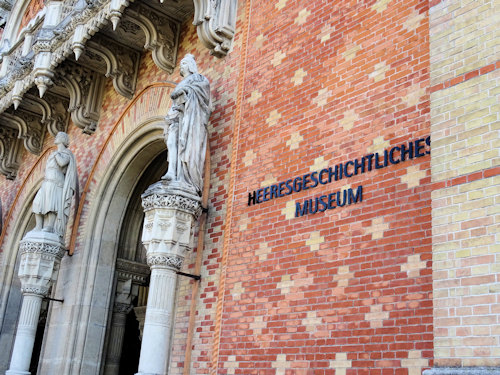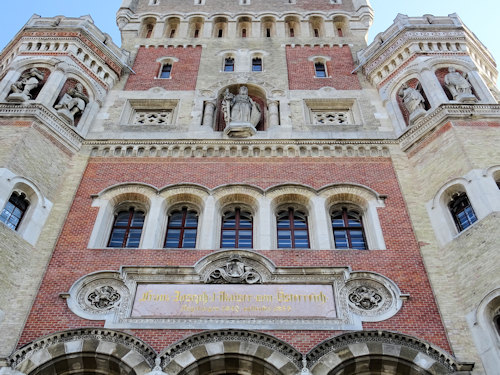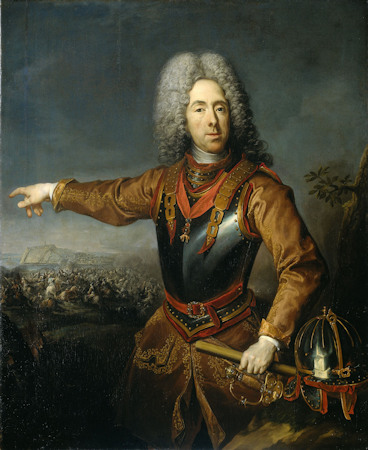
Austria’s history isn’t all Mozart and chocolate. The Habsburgs and Austrians added their blades or bullets to numerous historical conflicts, including the Thirty Years, Napoleonic, and World wars.
Vienna’s Heeresgeschichtliches Museum (Museum of Military History) tells the story…
- Gorgeous building with displays of arms, uniforms, military memorabilia, and art
- Some items of extraordinary historical relevance
- WWI exhibit is quite an eye-opener for US/UK visitors
- Some galleries may be closed for renovation (see below)
- Book a 2.5hr tour of WWII Vienna*
- See also:
- One-time free entry with a Vienna Pass
- WWII locations in Vienna
- Vienna Museums
Inside the museum

(The building is not as old as it looks)
You don’t need to be a fan of military matters to get something out of the Heeresgeschichtliches Museum.
I see it more as a history museum with a focus on the military, taking you on a chronological journey from the 17th century through to WWII and beyond.
At the beginning, the displays are full of colour, the glorification of victory, and the veneration of military commanders.
With time, though, the atmosphere changes, as mechanisation, industrialisation, the loss of individuality, and the brutality of war takes priority.
That transition is not explicit, but one you experience yourself as you walk through the galleries.
The museum building

(The architecture combines eras of the past)
Like so many Viennese museums, it pays to look up and around when wandering through the rooms and corridors within the Heeresgeschichtliches Museum.
The building itself dates back to the mid-19th century, purpose-built as a museum within a larger military complex known as the Arsenal.
The architecture draws on Byzantine, Gothic and Moorish design elements, reflecting the historicism so prevalent at the time in Vienna. The same architect (Theophil von Hansen) also built the city’s world-famous concert venue, the Musikverein.
Two rooms in particular almost outdo the exhibits.
Hall of Generals
Immediately inside the main entrance is a glorious vaulted hall with clusters of marble statues around a dozen columns.
Each statue portrays a famous military figure. As such, they represent almost a thousand years of Viennese and Habsburg military history.
All the “stars” are here, such as Archduke Karl, who inflicted the first defeat on Napoleon in many a year at the Battle of Aspern-Essling in 1809.
Sadly, Karl barely had time to pose for the cover of Cavalry Monthly before Napoleon hit back to score a rather more decisive victory at the Battle of Wagram.

(Portrait of Prince Eugene, whose military exploits feature heavily in the museum; photo courtesy of the Rijksmuseum)
Prince Eugene of Savoy, who battered the Ottomans, French and Italians in the late 17th and early 18th centuries, also has a statue. His former residence (now a prestigious art museum) is not far from here and full of martial decoration honouring his battle skills.
Hall of Glory
You go up the stairs, nodding approvingly at the outstanding architecture of the Hall of Generals, only to have your mind blown by the Hall of Glory: three vaulted halls with a giant central dome and more marble than you can shake a pike at.
45 (!) ceiling frescoes by Carl von Blass form a picture book of Austria’s military history, depicting numerous famous scenes and victorious battles. (Astonishingly, the losses don’t get quite the same attention.)
Incidentally, both halls make an appearance in Season 2 of the popular international period detective series Vienna Blood.
The exhibits

(Some of the many cannons on display)
The Heeresgeschichtliches Museum does a fine job of providing information in English: each section has a leaflet explaining the context, contents, and purpose of the room, plus a description of individual items of particular historical interest.
This approach frees up the museum to keep labels to a minimum in many areas, creating a very uncluttered environment to peruse the displays (apart from in the WWI section, for obvious reasons).
Some of the newer exhibits (like that WW1 section) have bilingual labels on individual items, too.
The galleries covering early military history burst with arms, uniforms, flags, paintings, and mementos of battle, as well as memorabilia associated with some of the famous military personalities of the time.

( Archduke Franz Ferdinand, photographed by Karl (Carl) Pietzner sen. probably aropund 1899; Wien Museum Inv.-Nr. 27455; excerpt reproduced with permission under the terms of the CC0 licence. The car he rode in on a fateful day in 2014 features in the museum)
Later galleries include the weapons and machines of war, too, but also exhibits related to the wider context: propaganda, medicine, etc.
And some of those exhibits may well take your breath away.
You probably definitely read about one or two in your history books (wherever you live in the world). See the museum highlights article for details of the most impressive items.
All-in-all, a visit makes a fascinating journey that manages to combine some quite extraordinary historical items with a subtle touch of education and sociopolitical commentary.
Ticket & visitor tips

(A statue of a rather pensive soldier outside)
At the time of writing, a standard adult ticket to the Heeresgeschichtliches Museum cost €7; a Vienna Pass gets you one-time free entry (see my review).
A couple of extra visitor tips:
- The correct order for doing the museum chronologically is:
- Start upstairs (go left at the top of the stairway first)
- Doubleback afterwards to do the right side
- Go back downstairs (turn left first)
- Doubleback across through the shop to the final exhibition halls
- Buildings just outside the main museum contain two further exhibitions (I missed these on my visit):
- Artillery halls: medieval cannons through to the 20th century
- Special armoured vehicle exhibition (very limited opening days): traces, for example, the development of armoured technology through to WWII and features 30 vehicles
- Your ticket includes an audio guide, but you can still enjoy the exhibits without using it thanks to the leaflets
- Note that some galleries may be closed for renovation or reorganisation. At the time of writing, this includes the galleries dealing with…
- Austria 1918-1945 (with a planned reopening sometime in 2025)
- The 16th to late 18th centuries, including the siege of Vienna (date of reopening TBA)
- The Heeresgeschichtliches Museum also hosts related events. For example:
- Montur and Pulverdampf: 2-day medieval festival
- Advent market: popular multi-day event with a historical flavour
- On Wheels and Tracks: 3-day military old-timer meet
- GoModelling: sadly no longer held
How to get to the museum
The Arsenal is quite a large complex and a little out of the way. So wherever you land on public transport, you’ll need to walk a few minutes to get to the museum.
Tram/bus: Take the 69A bus to Arsenal, the D or O trams to Quartier Belvedere, or the 18 tram to Heinrich-Drimmel-Platz. The D leaves from the edge of the old town, for example.
Subway: Take the U1 to Hauptbahnhof and walk, but I’ve given up trying to navigate out of that station. Sacrifice your first born and hope the Gods lead you to the correct exit. Catch the U1 at Stephansplatz right in the centre of town, for example.
Car: There is some free parking directly in front of the museum (see the website below for details).
Address: Arsenal, Objekt 1, Ghegastraße, 1030 Vienna | Website